24.07.2025
Whisky Brands and Watches Brands: A Creative Comparison
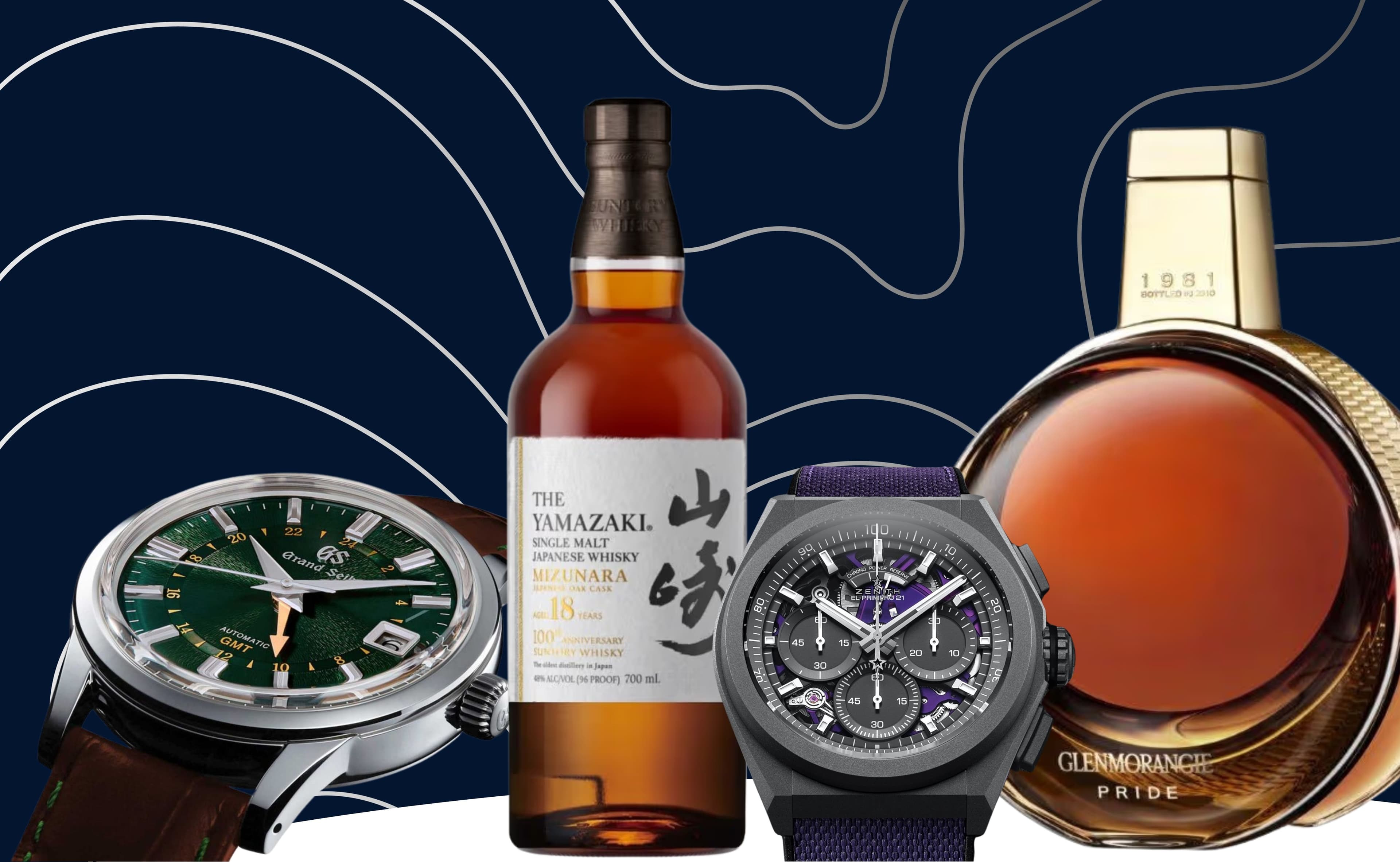
Whisky Brands and Watches Brands: A Creative Comparison
Picture this: you pour a glass of your favorite whisky, the amber liquid catching the light as you check the time on your wrist. Watches and whisky both invite you to slow down and savor the finer things in life. You see artistry, heritage, and personal style in every detail. These worlds thrive on craftsmanship and indulgence, drawing you in with a love for spirits and the magic of time. Have you ever felt that special connection between watches and whisky?
Key Takeaways
-
Whisky and watches both showcase expert craftsmanship, with years of skill and patience behind every bottle and timepiece.
-
Heritage plays a key role, as both industries honor long histories and traditions that add soul and value to their products.
-
Whiskies engage multiple senses through taste and aroma, while watches appeal mainly to sight and touch, offering unique sensory experiences.
-
Collecting watches tends to be more stable and easier to trade, while whisky collecting requires patience and careful storage but can offer big rewards.
-
Creative pairings and collaborations between whisky and watch brands celebrate shared values like artistry, culture, and exclusivity.
Similarities
Craftsmanship
When you hold a glass of scotch or glance at exquisite timepieces, you notice the care that goes into every detail. Both worlds demand patience and skill. Master distillers and watchmakers spend years perfecting their craft. You can see this in the way they select materials, control every step, and never rush the process.
Both whisky and watches rely on small batches, careful hands, and a focus on quality. The same way a watchmaker polishes gears and sets jewels, a distiller checks every barrel and waits for the right moment. Time is the secret ingredient in both crafts.
Tip: Next time you sip a scotch or admire a luxury watch, think about the years of dedication behind it.
Heritage
Heritage gives both whiskies and timepieces their soul. When you explore the history of a distillery or a watch brand, you step into a story that began long before you were born. Some distilleries, like Wolfburn, started in 1821 and still honor their roots today. Others, like Benromach, reopened after a hundred years, keeping old traditions alive.
Watches also carry stories from the past. Many brands use designs and techniques passed down through generations. You might notice how both industries celebrate anniversaries and special editions, marking the passage of time with pride. Heritage is not just about age; it’s about respect for what came before and a promise to keep those values alive.
Artistry
Artistry shines in every bottle of whisky and every luxury watch. You taste it in the layers of flavor in a fine scotch. You see it in the curves and colors of a beautiful watch face. Both crafts invite you to use your senses—taste, smell, sight, and even touch.
Whiskies offer a world of aromas and flavors, from smoky peat to sweet vanilla. Each bottle tells a different story. Watches, on the other hand, dazzle you with their design and movement. The way light dances on a polished case or the smooth sweep of a second hand can feel almost magical.
-
Both whiskies and timepieces reward those who pay attention to detail.
-
You discover something new every time you explore a new bottle or a new watch.
Time connects these worlds. Whisky needs years to mature, while watches measure every second with precision. When you enjoy both, you celebrate the beauty of waiting and the thrill of the present moment.
Differences
Sensory Experience
You notice the first big difference as soon as you open a bottle or glance at your wrist. Whiskies invite you to use your senses in a way that watches never can. When you pour a single malt, the aroma fills the air. You swirl the glass and see the color, then taste the flavor. Each sip brings out a new flavor profile—maybe smoky, maybe sweet, sometimes even a hint of fruit or spice. The experience is rich and layered, changing with every aged quality whisky or rare cognac you try.
Watches, on the other hand, speak to your eyes and your sense of touch. You feel the weight of a luxury timepiece. You see the shine of the case, the movement of the hands, and the details on the dial. The pleasure comes from the look and the feel, not from taste or smell. You might compare it to admiring a beautiful painting or sculpture. Both worlds offer deep enjoyment, but they reach you in different ways.
Tip: Next time you enjoy a single malt or a fine cognac, close your eyes and focus on the flavor profile. Then, look at your watch and notice how it feels on your wrist. You’ll see how each brings something unique to your senses.
Production
The way whiskies and watches come to life could not be more different. You see this in the materials, the process, and the role of time. Distillers start with simple ingredients—water, barley, yeast—and turn them into something magical. The whisky ages in barrels for years, sometimes decades. The wood, the air, and the passing seasons all shape the final flavor. Each bottle of single malt or aged cognac tells a story of patience and nature.
Watchmakers use metal, jewels, and glass. They cut, polish, and assemble hundreds of tiny parts by hand. The process demands precision and skill. Every gear and spring must fit perfectly. Time matters here, too, but in a different way. Instead of waiting for flavor to develop, you see time measured and displayed with perfect accuracy.
-
Whiskies rely on nature and aging.
-
Watches depend on engineering and design.
You might find it amazing how both crafts use time, but for different reasons. One lets time create flavor, the other captures time itself.
Collectibility
If you love collecting, you’ll notice some big differences between whiskies and watches. The world of rare watches is mature and transparent. Brands like Rolex and Patek Philippe have a long history of strong demand. Auction results show steady appreciation, with watches like the Patek Philippe Grandmaster Chime selling for over $31 million. The market is large and growing, expected to reach $97 billion by 2034. You can usually find clear records of ownership and quick sales if you want to trade or upgrade your collection.
Whiskies, especially rare bottles, have also seen huge gains. Some bottles, like The Macallan Adami 1926, have sold for millions. Over the past decade, rare whiskies have appreciated by more than 280%. However, the market can be unpredictable. Prices dropped by 9% in 2023, and you face challenges like storage costs, regulations, and long holding periods. You need patience and knowledge to succeed. Unlike watches, whiskies get rarer as people drink them, which adds to their value but also makes them harder to find.
Here’s a quick look at how the two compare:
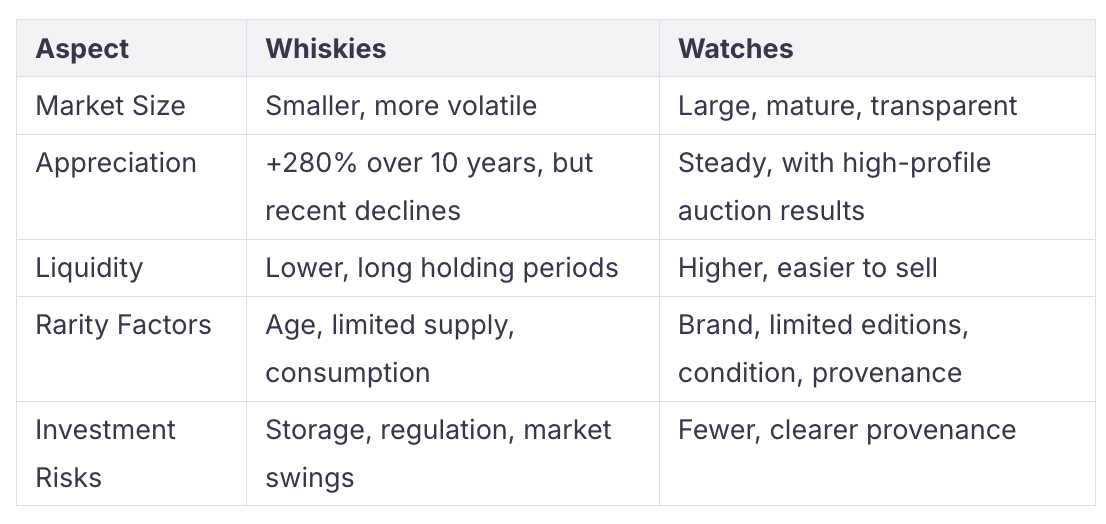
-
Collecting whiskies means you chase flavor, age, and rarity.
-
Collecting watches means you look for craftsmanship, history, and brand prestige.
Note: If you want to invest, remember that watches usually offer quicker sales and clearer records. Whiskies can bring big rewards, but you need to know the risks and be ready to wait.
Pairings
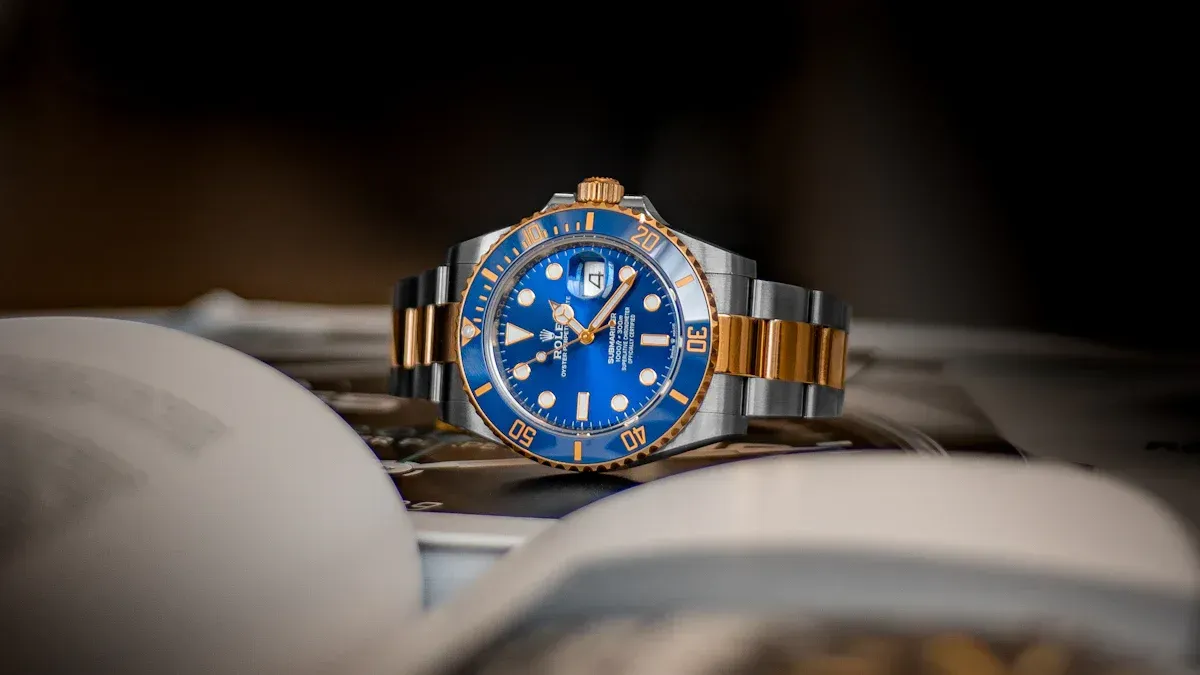
Whisky and Watches
You might wonder how top-shelf spirits and high-end timepieces come together. Some brands just seem made for each other. Take a look at these creative pairings:
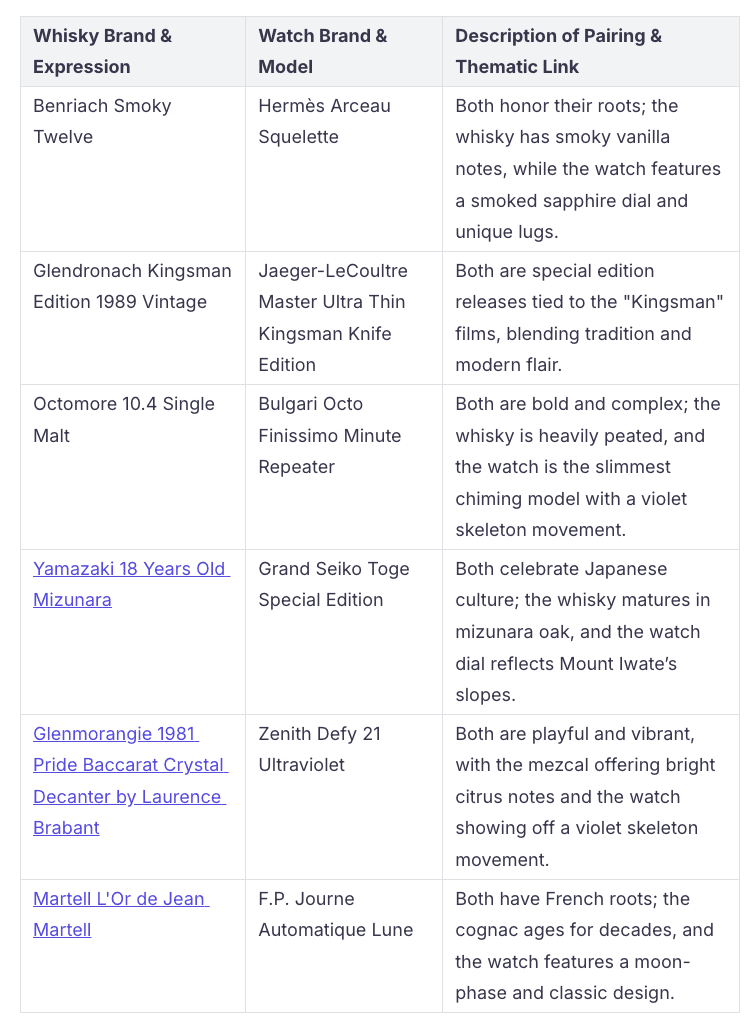
Tip: Try matching your favorite vintage timepiece with a super-premium bottle. You might discover a new ritual that feels just right.
High-End Timepieces
High-end timepieces and top-shelf spirits share a love for detail and exclusivity. When you hold a special edition watch, you feel the same thrill as opening a rare bottle of whisky or cognac. Some collectors even choose their drink to match the mood of their watch. Japanese craftsmanship stands out here, with brands like Grand Seiko and Yamazaki both focusing on nature, tradition, and artistry. You can see how these worlds overlap in their pursuit of perfection.
Creative Collaborations
You see more creative collaborations every year. Brands team up to launch special edition releases that celebrate both watches and whisky. The Glendronach and Jaeger-LeCoultre partnership for the Kingsman franchise is a great example. These collaborations often feature unique packaging, limited runs, and shared stories. You get a taste of both worlds—spirits and high-end design—in one unforgettable experience. If you love collecting, these special edition pairings offer something truly unique.
Market Impact
Luxury Appeal
You see the power of luxury every time you look at the global market for watches and whisky. These products do more than tell time or fill a glass. They shape trends and set standards for what people call true quality.
-
The luxury watch market reached $28.43 billion in 2022 and keeps growing at a steady pace.
-
Rolex leads with a 23.4% market share, showing how much brand prestige matters.
-
Limited production, hand-finishing, and rare materials drive up prices.
-
Some watches sell for much more than their original price, especially special edition models.
-
Top brands like Omega, Cartier, and Patek Philippe hold most of the market power.
The scotch whisky market also thrives on exclusivity and heritage. You notice how rare bottles and unique releases attract collectors and investors. Both industries show you that luxury is about more than just owning something—it’s about being part of a story.
Digital Innovation
You live in a digital world, and both whisky and watches have embraced this change. Brands now use technology to tell stories and connect with you in new ways. For example, Martell Noblige and CHIVAS have used augmented reality (AR) to let you explore their history and mixology right from your phone. You can even try on a japanese watch virtually with WebAR platforms, making shopping more fun and interactive.
Whisky tours in Edinburgh now blend tradition with data-driven insights. You get personalized tasting experiences and learn about regional flavors. These digital tools help brands build stronger relationships with you and make every moment feel special.
Culture
Luxury goods like watches and whisky reflect your values and shape your choices. Studies show that people in different countries buy these items for many reasons—investment, function, personal style, or social status. The japanese watch and whisky market, for example, highlights how culture shapes what you value in a product.
Whisky brands focus on authentic storytelling and transparent branding. They know that cultural appeal and rising consumer knowledge drive trends. When you choose a bottle or a watch, you connect with a tradition that fits your own story.
You see how whisky and watches share a love for heritage, artistry, and personal style. Both worlds keep evolving as trends shift and collectors seek new experiences. Take a look at these standout stats:
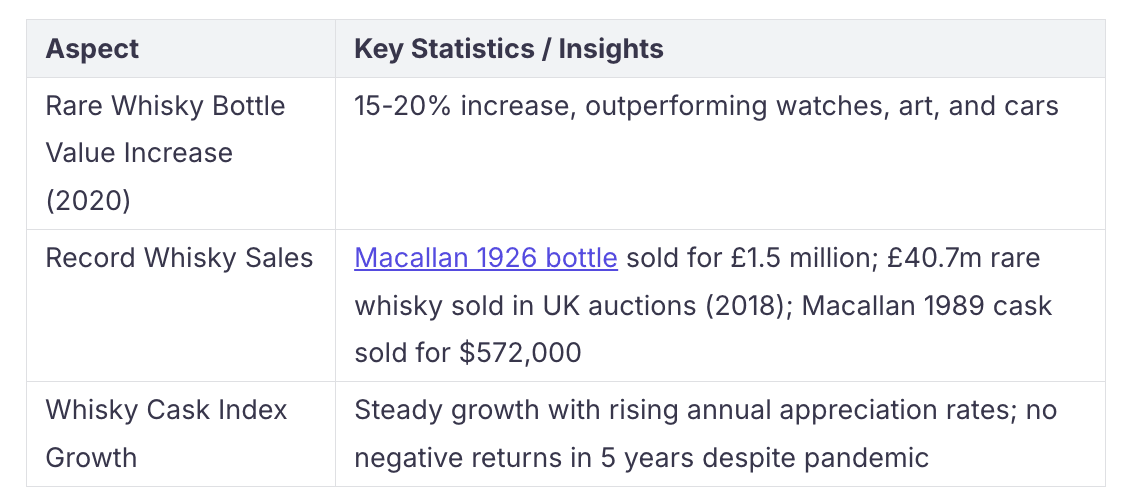
-
Younger drinkers now prefer premium spirits.
-
Online sales and AI tools help you find new favorites.
-
Ready-to-drink cocktails and non-dairy liqueurs are on the rise.
Maybe you have a favorite pairing or a story to share. Drop your thoughts below and let others know what makes your whisky and watch moments special. Explore, taste, and discover—your next great combination could be just around the corner!
FAQ
What makes a whisky brand pair well with a watch brand?
You want brands that share values like craftsmanship, heritage, or innovation. When you match a bold whisky with a daring watch, you create a unique experience. Look for brands that tell a story together.
Can you collect both whisky and watches as investments?
Yes, you can! Both markets offer rare finds and potential value growth. Watches usually sell faster and have clearer records. Whisky can bring big returns, but you need patience and good storage.
How do I start exploring creative whisky and watch pairings?
Start with what you love. Pick your favorite whisky and match it with a watch that feels right for the occasion. Try pairing Japanese whisky with a Grand Seiko or a smoky Scotch with a classic Swiss watch.
Are there any risks in collecting rare whiskies or watches?
Absolutely. You face risks like market swings, fakes, and storage issues. For whisky, improper storage can ruin value. For watches, condition and authenticity matter most. Always research before you buy.
About the author

Janis Wilczura
I started my Whisky journey like many others - I have had a friend who was already into it. After some time in Montreal I moved to Munich in 2015 where I met one of my best friends Ferdinand who was passionate about Whisky already and shared his enthusiasm with me. I fell in love with this product and today I can say that Whisky is more for me than just "Alcohol" it's craftmanship, art and truly something special. Over the course of the past years I have managed to become one of the leading experts in Whisky in Germany featuring articles ar BILD.de, Handelsblatt, Sueddeutsche, Playboy, Business Punk and many more.
To the author